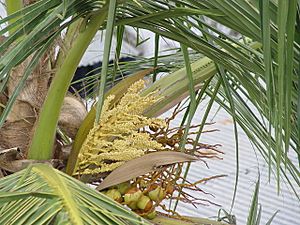Hainuwele facts for kids
Quick facts for kids Hainuwele |
|
|---|---|
| Deity that gave origin to the main vegetable crops | |
| Affiliation | Origin myths, Phosop |
| Abode | Seram |
| Symbol | Coconut flower |
| Mount | none |
| Parents | Ameta (Father) |
Hainuwele, also known as "The Coconut Girl," is a special figure from the stories of the Wemale and Alune people. These groups live on the island of Seram in the Maluku Islands, Indonesia. Her story is an origin myth, which means it explains how something important in the world came to be.
A German expert named Adolf Ellegard Jensen wrote down the myth of Hainuwele. He learned about it during his travels to the Maluku Islands in 1937–1938. Jensen studied this story while researching how different cultures understood religious sacrifice.
Contents
The Myth of Hainuwele
Long ago, a man named Ameta was hunting. He found a coconut caught in the tusk of a wild boar. This was amazing because no one had ever seen a coconut on Seram before! Ameta was part of the first nine families of the West Ceram people. These families were believed to have come from bananas.
Ameta took the coconut home. That night, someone appeared in his dream. This dream figure told him to plant the coconut. Ameta followed the instructions. In just a few days, the coconut grew into a tall tree and began to bloom.
Ameta climbed the tree to cut the flowers. He wanted to collect the sap. As he was working, he accidentally cut his finger. A drop of his blood fell onto one of the blossoms.
Nine days later, Ameta found something incredible. In the place where his blood had fallen, there was a baby girl! He named her Hainuwele, which means "Coconut Branch." He wrapped her in a sarong and brought her home. Hainuwele grew up incredibly fast.
Hainuwele's Special Gift
Hainuwele had a truly unique talent. She could magically produce valuable items. Because of this amazing ability, Ameta became very rich.
One day, Hainuwele went to a dance that was going to last for nine nights. This dance took place at a spot called Tamene Siwa. It was a tradition for girls at this dance to give areca nuts to the men. Hainuwele did this, but when the men asked for nuts, she gave them the valuable things she could create instead.
Each day, she gave them something bigger and more precious. She gave them golden earrings, coral, porcelain dishes, bush-knives, copper boxes, and gongs. At first, the men were very happy with these gifts.
However, as time went on, they started to feel uneasy. They thought what Hainuwele was doing was strange. Soon, their happiness turned into jealousy. They decided that they needed to get rid of her.
The Dance and Hainuwele's Fate
During the dances, the men would circle around the women. Hainuwele was among the women in the center, giving out her gifts. Before the ninth night, the men secretly dug a deep pit in the middle of the dance area.
On the ninth night, as the dance continued, the men began to push Hainuwele. They pushed her closer and closer to the center. Finally, they pushed her right into the pit they had dug. The men quickly piled earth over her, covering her cries with their loud singing. Hainuwele was buried alive, and the men kept dancing on the dirt, stomping it down firmly.
The Transformation
Ameta missed Hainuwele very much. He went looking for her. He used an oracle to find out what had happened. The oracle told him the truth. Ameta then dug up her body. He cut it into pieces. He then re-buried these pieces around the village.
From these buried pieces, many new and useful plants grew. These included different kinds of tubers. This is how the main foods that the people of Indonesia have eaten ever since came into existence.
Ameta also took Hainuwele's cut arms to mulua Satene. She was the ruling deity, or god, over humans. With Hainuwele's arms, Satene built a special spiral-shaped gate. All humans had to pass through this gate.
Those who could step across the gate would remain human beings. However, from then on, they would be mortal, meaning they would eventually die. They also became divided into two groups: Patalima (Men of the five) and Patasiwa (Men of the nine). Those who were unable to pass through the gate became new kinds of animals or ghosts. Satene herself left the Earth and became the ruler of the land of the dead.
The Patasiwa group is the one that both the Wemale and Alune people belong to.
See also
 In Spanish: Hainuwele para niños
In Spanish: Hainuwele para niños


